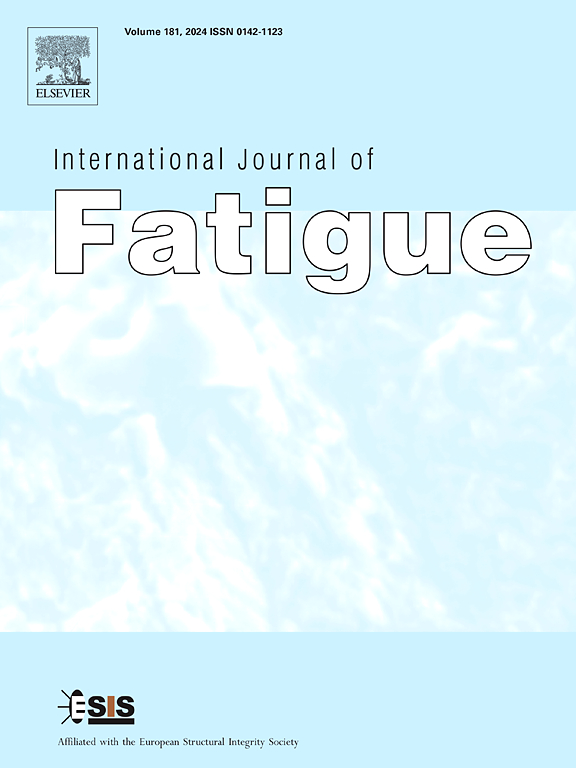超声疲劳试验机的统计校正与概率疲劳寿命估计
IF 6.8
2区 材料科学
Q1 ENGINEERING, MECHANICAL
引用次数: 0
摘要
提出了一种新的统计方法来量化金属超声疲劳试验中观察到的实验不确定性,并将其传播到应力-寿命预测曲线中。本文首次将层次贝叶斯方法应用于超声疲劳试验的标定和操作步骤。这一点尤其重要,因为在高周疲劳状态和非常高周疲劳状态下,观察到的应力寿命数据存在显著的分散。首先,测量系统,包括位移激光读数和高速摄像系统输出,进行交叉校准。其次,采用统计学习方法建立应力-变形关系,利用数字图像相关(DIC)测量应变和激光位移在超声波机器试样尖端测量。第三,通过结合学习到的应力分布和疲劳失效循环的分布,引入了一个额外的层次来推断应力寿命曲线的不确定性。结果确定了UFT中不确定性的关键来源,并证明了层次贝叶斯方法为量化这些不确定性提供了系统框架。本文章由计算机程序翻译,如有差异,请以英文原文为准。
Statistical calibration of ultrasonic fatigue testing machine and probabilistic fatigue life estimation
A new statistical technique is proposed to quantify the experimental uncertainty observed during ultrasonic fatigue testing of metals and its propagation into the stress-lifetime predictive curve. Hierarchical Bayesian method is employed during the calibration and operation steps of ultrasonic fatigue testing for the first time in this paper. This is particularly important due to the significant dispersion observed in stress-life data within the high and very high cycle fatigue regimes. First, the measurement systems, including displacement laser readings and high-speed camera system outputs, are cross-calibrated. Second, a statistical learning approach is applied to establish the stress-deformation relationship, leveraging Digital Image Correlation (DIC) measurements of strain and laser displacement measurements at the ultrasonic machine specimen’s tip. Third, an additional hierarchical layer is introduced to infer the uncertainty in stress-life curves by incorporating learned stress distributions and the distribution of fatigue failure cycles. The results identify key sources of uncertainty in UFT and demonstrate that a hierarchical Bayesian approach provides a systematic framework for quantifying these uncertainties.
求助全文
通过发布文献求助,成功后即可免费获取论文全文。
去求助
来源期刊

International Journal of Fatigue
工程技术-材料科学:综合
CiteScore
10.70
自引率
21.70%
发文量
619
审稿时长
58 days
期刊介绍:
Typical subjects discussed in International Journal of Fatigue address:
Novel fatigue testing and characterization methods (new kinds of fatigue tests, critical evaluation of existing methods, in situ measurement of fatigue degradation, non-contact field measurements)
Multiaxial fatigue and complex loading effects of materials and structures, exploring state-of-the-art concepts in degradation under cyclic loading
Fatigue in the very high cycle regime, including failure mode transitions from surface to subsurface, effects of surface treatment, processing, and loading conditions
Modeling (including degradation processes and related driving forces, multiscale/multi-resolution methods, computational hierarchical and concurrent methods for coupled component and material responses, novel methods for notch root analysis, fracture mechanics, damage mechanics, crack growth kinetics, life prediction and durability, and prediction of stochastic fatigue behavior reflecting microstructure and service conditions)
Models for early stages of fatigue crack formation and growth that explicitly consider microstructure and relevant materials science aspects
Understanding the influence or manufacturing and processing route on fatigue degradation, and embedding this understanding in more predictive schemes for mitigation and design against fatigue
Prognosis and damage state awareness (including sensors, monitoring, methodology, interactive control, accelerated methods, data interpretation)
Applications of technologies associated with fatigue and their implications for structural integrity and reliability. This includes issues related to design, operation and maintenance, i.e., life cycle engineering
Smart materials and structures that can sense and mitigate fatigue degradation
Fatigue of devices and structures at small scales, including effects of process route and surfaces/interfaces.
 求助内容:
求助内容: 应助结果提醒方式:
应助结果提醒方式:


